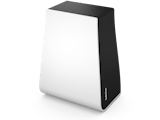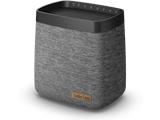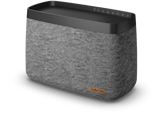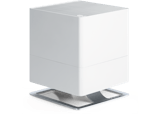
Usha Müller, 27 September 2021
Humidify the air
10 reasons to get a humidifier
Dry air primarily develops indoors when the outdoor temperature drops and the central heating is turned up as far as it will go. You can try to get rid of this dry air by ventilating rooms, hanging up washing or putting out bowls of water. These are short-term measures and only increase the water content in the air very briefly, if at all. Airing the room has the opposite effect as in principle, cold air cannot absorb as much humidity as warm air. When you ventilate rooms in winter, the cold air warms up with less water being dissolved and the relative humidity indoors drops. As a result, when it is cold outside we have to endure unpleasantly dry air indoors, with relative humidity of well below 40%.
1. Staying healthy
During the colder months, we have to put up with dry mucous membranes, sore throats, coughs and dry – or in extreme cases even bleeding – noses. Our mucous membranes need a certain level of humidity to stop them from becoming inflamed. With sufficient humidification, our mucous membranes act as a barrier to pathogens. For that reason, the dry indoor air must be enriched with steam in order to enable the humidity to increase to a healthy value. If the level of humidity is not high enough, it puts a strain on our whole immune system and makes us ill. In addition, flu viruses are able to survive for longer in dry air than in rooms where there is an ideal indoor climate, thus increasing your chances of falling ill.2. Restful sleep
If an indoor climate is not humid enough, it can cause restless sleep. An excessively low level of humidity below 40% will place our bodies under greater strain compared with a good humidity value of around 50%. If the air is optimally saturated, our bodies are able to relax. Babies and young children react particularly sensitively to an unbalanced, excessively dry indoor climate. This can be remedied by using a humidifier to increase the indoor humidity and thus ensure better sleep. In the case of colds and flu, an optimal level of humidity can improve symptoms like a blocked nose and cough so that you can sleep better.3. Breathe more freely
Most allergy sufferers notice the presence of pollen and dust particles in the air particularly at the end of winter and in spring when temperatures rise again. Insufficiently humidified indoor air promotes the dispersion of small particles enormously. By humidifying the air, these suspended particles bind together better, making them heavy so that they fall to the ground. This prevents these small particles from dispersing and there are fewer irritations.4. Less snoring
We all need to get enough sleep in order to stay healthy. However, if your roommate, partner or neighbour snores, it can massively disrupt your sleep. In particular, a person’s snoring can become even heavier if they have a cold which gives them a blocked nose and throat – making it more difficult to breathe. Using a humidifier to ensure that there is adequate humidity in the room can help clear the airways and provide a lasting solution to a person’s snoring problem.5. See more clearly
Itchy, burning or sticky eyes in winter are a sign of excessively low humidity. If the surface of the eye becomes too dry, it can be very unpleasant. In the longer term, insufficient humidity can result in lasting damage to the eyes and the impairment of vision. An indoor air humidifier provides a quick and efficient solution to this problem. If we increase the saturation of the water vapour in the air, we can blink again without any problems and generally feel better. Contact lens wearers in particular can benefit from well-humidified indoor room air because when there is optimum humidity, contact lenses no longer stick to the eye and eye irritation is reduced.6. Healthier skin
Our skin needs a stable level of humidity. Besides appropriate cosmetic products, a healthy indoor climate is essential for keeping skin firm and healthy. If we spend long periods of time in environments where the indoor climate is poor, our skin will not be provided with the humidity it needs and as a result, it will become dry.7. Thriving houseplants
Soil is extremely efficient at storing water. If the relative humidity indoors is too low, the air will also take the moisture it needs from the soil in which houseplants are planted. This process takes much-needed water away from the plants which can quickly dry out as a result. Using a humidifier to increase the relative humidity can benefit not only our health but also that of our plants.8. Mild indoor climate for wooden furniture, parquet flooring and valuable paintings
If the humidity is too low, the moisture will be drawn from solid materials and items such as furniture, walls and flooring first of all. As a result, over time wooden furniture and parts of the infrastructure will become cracked and brittle. Damage can also be caused to paintings and other wooden objects if there is an insufficient level of humidity in a room. This can be counteracted by having a good indoor climate with the right level of humidity. For example, retailers of wooden flooring will recommend a certain humidity (between a minimum of 40% and a maximum of 60% relative humidity) at the time of sale as otherwise the quality of the flooring cannot be guaranteed.9. Harmonious sounding musical instruments
Just like wooden furniture and parquet flooring, wooden musical instruments such as pianos, guitars and violins are extremely sensitive to fluctuating humidity in a room. A humidifier with integrated hygrostat can help prevent instruments from going out of tune. Fluctuations in the indoor climate are compensated by the humidifier so that the wood retains its shape and the instrument remains perfectly in tune.10. No more static shocks
If there is sufficient humidity in the air, less static charging can occur due to the water in the indoor air, i.e. the higher the humidity, the lower the build-up of static electricity will be. By increasing the level of steam and creating a better indoor climate, statically-charged hair and clothes, as well as the unpleasant static shocks experienced between people and when touching metal, become a thing of the past.If you have questions related to indoor room climate, please get in touch with us. Or subscribe to our newsletter to regularly get informed about current topics regarding indoor climate, experience reports or Stadler Form insights.







